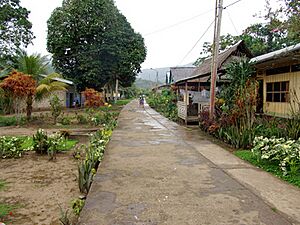Borja, Peru facts for kids
Quick facts for kids
Borja
|
|
|---|---|
| Founded | 1619 |
| Elevation | 165 m (541 ft) |
| Population
(2017)
|
|
| • Total | 329 |
Borja is a small town in the Loreto Region of Peru. It is located in the Datem del Marañón Province. This town sits right next to the Marañón River, about 165 meters (541 feet) above sea level. In 2017, about 329 people lived there.
Borja was started in 1619 by Spanish settlers. It was one of the very first Spanish towns in the lowlands of the Amazon Basin. Later, in 1638, it became a Roman Catholic mission run by the Jesuit Order.
Sadly, many local people, especially the Maina people, suffered from European diseases. They were also forced to work for the Spanish. Because of this, the population of Borja and nearby areas dropped a lot. It went from about 3,000 people in 1638 to only a few hundred by the late 1700s.
Contents
History of Borja
The first Spaniard known to visit the Borja area was Juan de Salinas y Loyola. He traveled through in 1557. He floated down the Marañón River through a wild water area called the Pongo de Manseriche. This area marks where the Andes mountains end and the flat Amazon Basin begins.
The town of Borja is about 2 kilometers (1.2 miles) past the Pongo. At that time, the Maina people lived there. They were one of many groups living in the region.
Founding of Borja
In 1619, a man named Diego Baca de Vega from Loja, Ecuador, founded the settlement of Borja. It was one of the first Spanish towns in the lowlands of the Amazon Basin.
Borja was named after the viceroy of Peru, Francisco de Borja y Aragón. A viceroy was like a governor who ruled a colony for the king of Spain.
Life for the Maina People
The local people in the Borja region were the Maina people. There were about three or four thousand of them when the Spanish arrived. The colonial government gave 21 Spanish settlers and mestizos (people of mixed Spanish and Indigenous heritage) something called encomiendas. This was a right to make the local people work for them.
Many Maina people died from diseases brought by the Europeans. Others died from being overworked. Some managed to escape from the encomiendas. In 1635, the Maina people protested and fought back against the Spanish. They were put down very harshly.
Jesuit Mission and Population Changes
When Jesuit missionaries arrived in 1638, about 2,800 Maina and other local groups lived there. There were also about 200 Spanish people, including a small group of soldiers. Borja became the main Spanish center for a region called Mainas.
To keep the population up, missionaries, soldiers, and Christian Indigenous people often went into the jungle. They would bring Maina and other groups back to Borja. Even with these efforts, the population kept going down. By 1661, there were only about 1,000 people. In 1776, the town had 263 Indigenous people and 152 Spanish and mestizos.
The Jesuit missionaries set up missions among many different groups. These missions covered an area as big as Spain. However, most of these missions did not last very long.
Isolation and Trade
Borja was a very isolated place. Travel to the highland areas of Peru was often through the town of Jaen. Jaen is about 210 kilometers (130 miles) southwest in a straight line.
In 1743, even in good weather, it took four days by road to get to Jaen. Then, it took two and a half days floating down the Marañón River, passing through the dangerous Pongo. When the river water was high, it was not possible to travel by river, and Borja became completely cut off.
Borja produced small amounts of tobacco and achiote (a plant used for dye and seasoning) to trade with Jaen.
See also
 In Spanish: Borja (Datem del Marañón) para niños
In Spanish: Borja (Datem del Marañón) para niños



